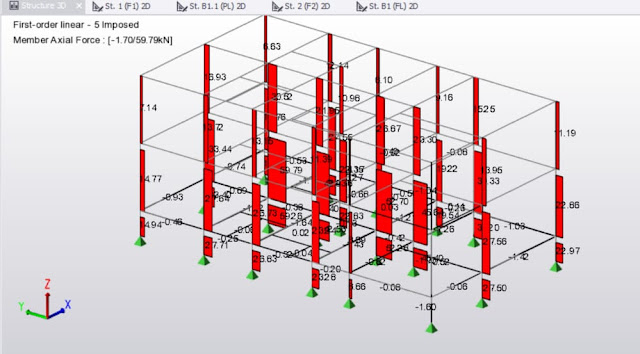INTRODUCTION TO STRUCTURAL ANALYSIS...PART ONE
Everyday construction activities are done for erection of different structures, the erected structures should be designed so they can be safe and serviceable for desired lifetime.
One
of the important stages in designing structures so that they can be safe and
serviceable is structural analysis.
Structural
analysis is an integral part of structural design which deals with determining
the stresses and resistance of structure to the loading.
In
analysis loads or stresses can be classified as external loads and internal
loads, where by external loads(stresses) comprises of applied loads and
reactions while internal loads comprises
of resultant forces, axial forces, shear forces and bending moment.
Reactions and supports
Support is any structural member that is provided to
carry or provide support to a loading.
Reactions are what the support offer as resistance when subjects to loading, so these are forces offered by supports to restrain the structure.
Reactions are always acting perpendicular (normal)
to the support or supporting surface or plane.
There are three types of support that are normally
seen or observed in structural analysis which are fixed support, pin support
and roller support.
Fixed support is the kind of support that has no translation or rotation in any direction; this means fixed support does not both allow movement of a structure and rotation about a point in any direction.
So, the fixed support offers three resistances
(reactions) two in translation (vertically and horizontally restrained) and in
rotation of a structure (moment is restrained).
Pin support is the kind of support that has no
translation in any direction but has rotation about a point, this means pin
support does not allow movement of structure in any direction but allow rotation
about a point. Below are the symbols of pin supports.
So, the pin support offers two reactions in
translation (vertically and horizontally restrained) and moment is not
restrained.
Roller support is the kind of support that has
translation in one direction and rotation in any direction, this means this
support allow movement in one direction (either vertically or horizontally
restrained) and moment is not restrained.
STABILITY OF THE STRUCTURE
In structural analysis the structures can be classified
as stable and unstable structures on basis of structural stability, stable
structures are further classified as determinate and indeterminate structure.
So in structural analysis we have determinate
structures, indeterminate and unstable structures.
Determinate structures
These are structures which provide resistance to
both effect that could result from loads without extra resistance or support
left, these structures are stable structures where by its stability depends on
both supports, failure of one support make it unstable.
The stability of the structure is the composite of
stability of its structural members, so determinate structural members make the
whole structure determinate.
Indeterminate structures
These are structures which provide resistance to
both effect that could result from loads with extra resistances or supports
left, these structures are stable structures where by its stability does not
depends on both supports, failure of one support does not make it unstable.
The stability of the structure is the composite of
stability of its structural members, so indeterminate structural members make
the whole structure indeterminate.
Unstable structures
These are structures which do not provide resistance
to both effects that could result from loads, these structures are unstable as
they allow either translation or rotation or both.
The stability of the structure is the composite of
stability of its structural members, so unstable structural members make the
whole structure unstable.
HOW TO CHECK STABILITY OF STRUCTURE
Stability of the structure is checked by determining
the degree of indeterminacy (n) of structure and then checks if it is determinate,
indeterminate or unstable structure.
For
determinate structure the degree of indeterminacy is "0", for indeterminacy
structure degree of indeterminacy is "greater than 0" and for unstable structure
the degree of indeterminacy is "less than 0".
For n = 0 (Statically determinate structure)
n > 0 (Statically indeterminate Structure)
n < 0 (Unstable structure)
Case 1. For a beam
From n = r-3 where n - Is degree of indeterminacy
r - Is the number of reaction in the
system.
Case 2. For a beam with internal support
From n =
r-(3+ec) where n - Is degree of indeterminacy
r - Is the number of reaction in the
system.
Internal support can be either internal hinge or internal roller where by ec for internal hinge is 1(ec = 1) as it lacks one resistance (moment restraint) and ec for internal roller is 2 (ec = 2) as lacks two resistances (one translation and moment restraints)
Case 3. For a truss
From n = r
+ m – 2j where n - Is degree of indeterminacy
r - Is the number of reactions.
j - Is the number of joints
For a full document click on button below









Thanks good explanation
ReplyDeleteWe are trying to deliver which can easily be understood, thank you!
ReplyDelete